Available Birds
Please note: if the adoption requirements include providing a cage, do not purchase one until an adoption counselor has approved the adoption. Having an appropriate cage does not ensure your application

All of the birds that we work with at HARP are very dear to our hearts, but as of now, there is only one Angel. He would like to say hello!
Angel is a 23-year old male (assumed) blue and gold macaw (also known as blue and yellow macaw). Macaws are amazing parrots, but there are many things that also make them difficult to own. Like many parrots, forming close social bonds is a priority for the blue and gold macaw, but because many B&G’s live into their 70’s and beyond, they often end up living in many different households – and that can have a great impact on their emotional and physical health.
So what are you doing with the next 50 years? Angel definitely is showing signs that he wants to build social attachments, but he is very, very cautious. Interacting with different people in his foster home in different ways is helping him learn to trust, little by little. His new owner will need to be extremely patient with this process, and understand that the bonds will be formed on Angel’s timeline, and no one else’s. His first owners got him from a breeder when he was very young, and finished hand feeding him. When they were unable to continue caring for him, Angel went to live with their now-adult son and his family. Even though Angel had lived with this person, and they tried to maintain a similar routine and handling practices, Angel began plucking and barbering his feathers upon joining their household. His foster has not seen him pluck or barber specifically, and has not found any feathers that appear plucked, but this is a possibility in the future. As of now, he is molting some old feathers, and new ones are coming in (it looks like there are follicles that are not destroyed); we are hopeful that he will allow them to grow in fully.
Angel’s diet was converted to the BirdTricks seasonal feeding system (a set of unique recipes of fresh veggies, legumes and grains that changes seasonally), and pellets, and he is an enthusiastic eater! He also gets a very small amount of nuts, which his foster uses as training rewards and as a way to bond (brazil nuts, walnuts, almonds, pistachios, and cashews are all favorites!). Angel is maintaining a healthy weight, with the help of lots of daily exercise!
Angel’s previous owner advised us that when he was about 10 years old, they suspect that Angel fell in his cage one night, because one of his wings was damaged and being held in a strange way. He has not been able to fly – yet! But someday, he may be able to at least glide or fly short distances.
Perhaps because he can’t fly, Angel is a bit of an acrobatic parrot, climbing and stretching, using his feet and his beak in feats of amazing strength and agility! He does have a playstand that he uses several times a day, but pretty much, when he is out of his cage, if there is a place he wants to be, he will figure out a way to get there. His foster has had to remove baskets that housed dog toys and blankets, because Angel sees them as potential nests, which raises his hormone levels. He has tried to climb into the backs of bookshelves, where it is nice and dark and hidden – another place that always looks a little bit nest-y! His new owner will need to understand the right (and wrong) ways to handle a parrot to mitigate hormones and avoid possible bites.
Angel has seen our avian vet a couple of different times, and has always come away with a good bill of health! He was disease tested, and all tests came back negative – yay! He is in a very large cage in his foster’s home (80”x40”), but these dimensions are still the minimum that he needs. A similar large cage or walk-in indoor aviary will be required in Angel’s new home, so if you are interested in adopting him, understand he will need a lot of space.
One important thing that Angel’s foster is continuing to work with him on is bathing. He is very frightened (unsure? Nervous about?) of any kind of bathing. His previous owners reported that they were able to take him into their shower, but when the foster tried to take him just into the bathroom while they showered, he became very heightened and upset. Spray bottles are also extremely scary, and he shows no interest in shallow dishes of water or the water in the sink. It will be very important that his new home is willing to continue this work, as bathing will be crucial for his health and improving his feathers and skin.
There were young children in Angel’s previous home, and he did display some aggression toward them. Any kids in Angel’s new home will be required to first meet him, and must be over the age of 12. We will require that all members of Angel’s new household are open and interested in interacting with him – this will help ensure that he does not fixate on one person and see anyone else as a threat.
In his previous life, Angel was an “only bird”, but is now part of a small flock in his foster home. None of the parrots are allowed out of their individual cages unsupervised, but Angel does show some healthy flock behaviors, including eating once all of the birds have their breakfast, or getting ready for the end of the day together.
Adopting a parrot like Angel is an enormous commitment, from financial and emotional responsibilities to time and space needs. The payoff is a lifetime companion and a bond with a very intelligent bird.
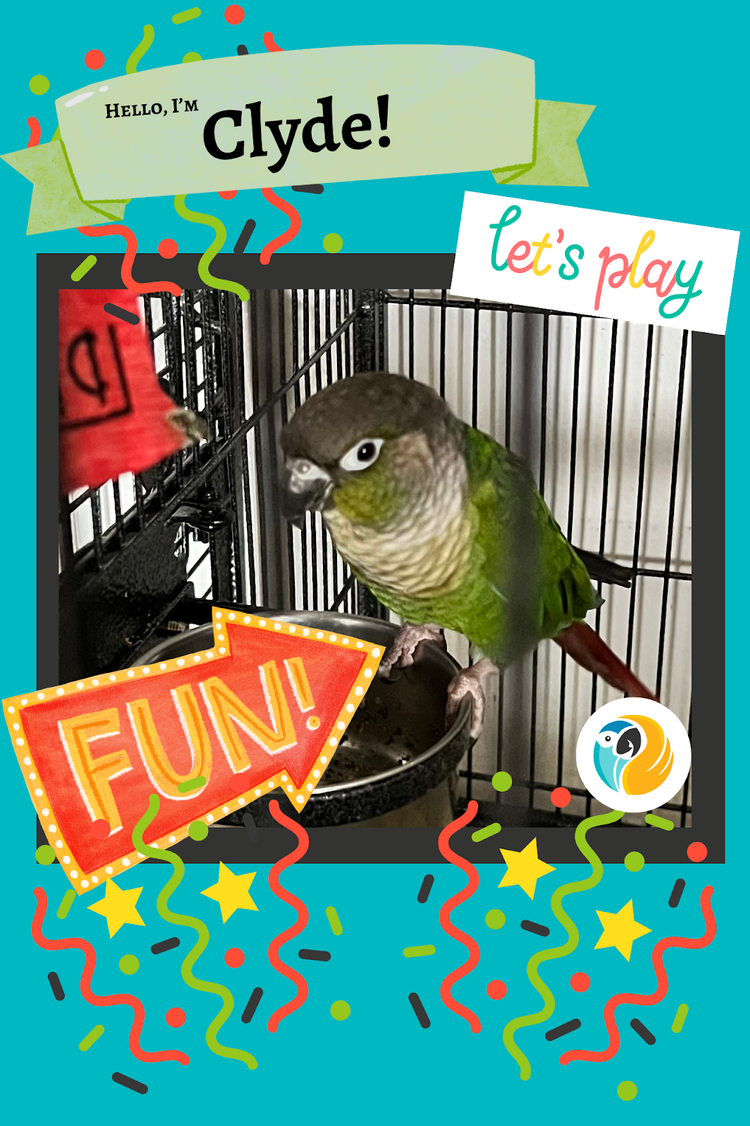
WANTED: ISO home for young male: he is gregarious, playful, intelligent, inquisitive, keeps a healthy diet, enjoys being part of a family or social group, can be fearful, and is fully feathered and (almost!) ready to fly!
Some parrots tell us pretty clearly that they are looking for a home that is a little more restrained, a little lower-energy, but others are looking for something completely opposite, and Clyde fits into this second category for sure. Clyde is a 5 year old, male (DNA), green cheek conure – he’s a whole lot of big parrot energy in a compact, colorful body! From the moment we met him and throughout his time with our foster family, Clyde has been friendly, chatty (he does know several words), and playful (he has a few different “sounds” that he also mimics well). He is not necessarily a noisy bird during most of the day, but he can (and does!) raise his voice if he thinks the house is TOO quiet for his liking.
There are a couple of somewhat unique details that we are looking for when it comes to finding Clyde’s forever home. First, Clyde has displayed a pretty specific preference for men. His previous (and only) owner was a young male, and he is currently living with a family with an older male; in both places, the women of the home have had more difficulty working with Clyde, but he seems smitten with men! Sometimes, birds like Clyde will meet and really click with someone we do not expect them to, and that is certainly a possibility, but his new home needs to have a male person who is interested in being Clyde’s main person.
The second somewhat unique thing about Clyde is that his previous owner followed BirdTricks pretty closely in terms of their diet and training philosophies, and we would like to find someone who will continue that work. Clyde’s diet is healthy, and he won’t need to be diet converted, which is a big plus! He eats a healthy breakfast of the BirdTrick’s seasonal feeding system (they offer a cookbook with the recipes that can be made ahead of time in bulk and then frozen into daily portions, or you might choose to utilize their freeze dried seasonal feeding diet where you only have to add a bit of water to a small portion each day), and either BirdTricks or TOPS pellets for his afternoon meal. Currently, Clyde’s preferred treat for training rewards are pine nuts, but he reserves the right to change his mind at any time!
If you are not familiar with BirdTricks, their name might be a bit misleading. Rather than training birds to entertain their owners, the true reason for training is to build a common language between human and parrot. Unlike our cats and dogs that are domesticated and have been bred for generations to be companions for humans, our parrots are still wild animals, no matter if they were living in the wild or born in captivity. It is important to understand this in order to work with any parrot effectively, and Clyde is the kind of bird who pretty much needs to feel like anything he does was his own idea first. He can be a bit nippy, and this was a primary concern his previous owner was working on through daily training sessions. Unfortunately, other commitments put that training on hold in recent months. Clyde will need someone in his new home who can work on training sessions daily (short sessions are best, and even one five minute training period a day can lead to meaningful change and building a great bond with Clyde).
Clyde is flighted, and we advise against clipping a bird’s wings unless medically necessary. This is another training opportunity, as his flight muscles have not been well developed, but recall training or indoor flight training is a great way to provide exercise and socialization time for Clyde.
Parrots like Clyde need several different kinds of enrichment on a daily basis, and flight is just one of them. According to his foster, Clyde enjoys toys that he can take apart, different items other than perches that he can climb on, and foraging toys (where a few pieces of nuts, pellets or veggies can be hidden and found). He also enjoys different kinds of music, as long as it isn’t TOO loud! Clyde will bathe on his own, in his water dish, regularly, so fresh water may need to be replenished more than once a day. Clyde does come with a fairly new cage, of an appropriate size for conures like him.
In his foster home, Clyde does enjoy “talking” back and forth with the resident conure, though they do not show signs of significant bonding or obsession. Parrots can form a flock and participate in flock behaviors even with birds of other species, and it does offer social enrichment. Any introductions to existing birds in the home should be done only after a thorough vet visit and at least a 30 day quarantine, and care must be taken if either bird has out of cage time to ensure there are is no aggression between parrots.
Clyde’s propensity for social interaction with people does extend down to children, and he has enjoyed the attention of our foster family’s younger family members. Because he can still be nippy, any kids in the home must be kept a good distance from the cage, as little fingers poking in between cage bars may look like good things to bite, at least to Clyde. So long as he can be at the center of the action, Clyde is a pretty happy, and very loveable (our foster family added that!) bird.
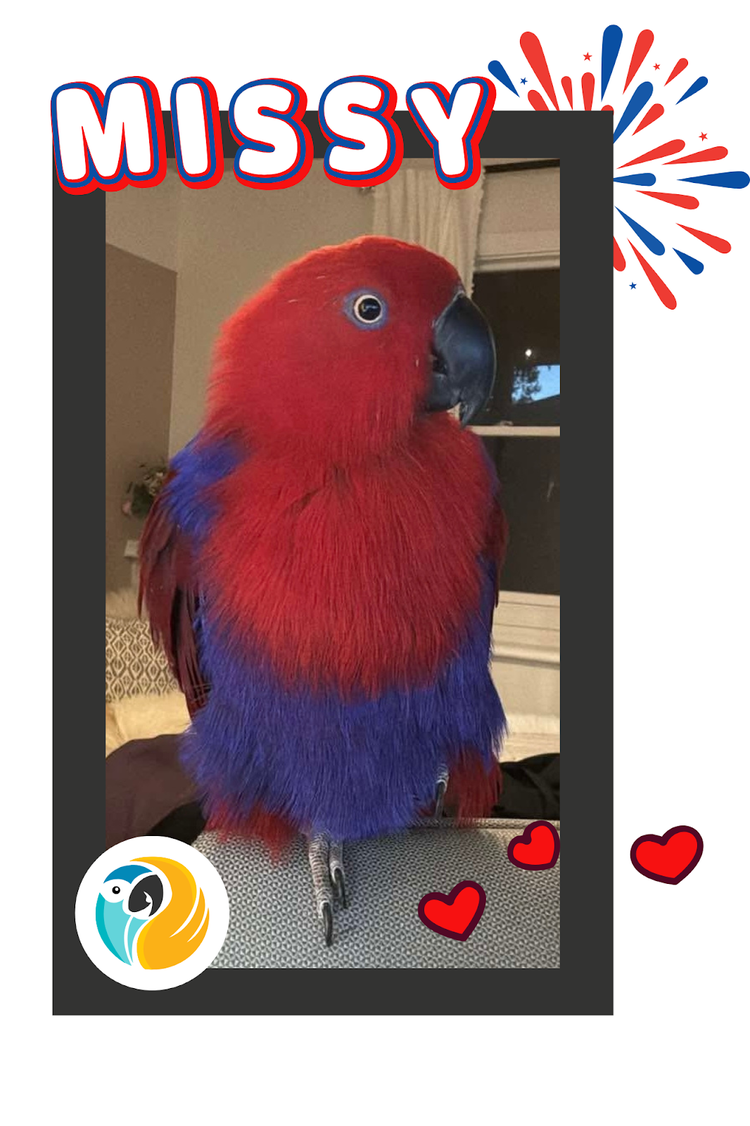
Over the past 15 months or so, HARP has worked with a wide variety of parrots, including budgies, cockatiels, conures, quakers, ringneck parrots, african greys, cockatoos, and macaws – oh my! Today, we want to introduce you to a parrot of another species, and this sweet girl is named Missy.
Missy is an eclectus parrot, and she is 9 years old. There are many unique things about eclectuses (yes, spellcheck, this is the correct spelling and term), one of them being that they are sexually dimorphic. Most parrots do not reveal their gender in any visual way, except for the eclectus. No, she is not just dressing up for the July Fourth holiday: male eclectus are mostly bright green, while females are a combination of red with blue and purple. There are five species of eclectus, and Missy is a Papuan (or Solomon) eclectus. (The Oceanic Eclectus is extinct, but its scientific name is Eclectus infectus!)
A stunningly beautiful bird, Missy’s first owners were likely unprepared for the reality of keeping an eclectus like her healthy and content. When she was 5, Missy was rehomed, and lived with a family who did extensive research on the appropriate ways to provide care and enrichment for her. When she showed signs of illness, they took her to see an experienced avian vet; sadly, her primary caregiver’s own health was in decline at the same time. They made the difficult decision to surrender Missy to our organization in order to give her a more stable life with someone who can continue monitoring her health and well-being.
Missy’s foster home continued treating her bacterial pneumonia, but she continued to display symptoms. After another visit to our avian veterinarian, Missy did another round of treatments, and seems to be doing better. Her forever home will need to stay on top of Missy’s medical care and conditions by having regular check ups with an avian veterinarian, and learning the symptoms she might display that would warrant a follow-up appointment.
The digestive system of the eclectus parrot is slightly different from other parrots, in that it is a little slower. Some experts believe this is due to a longer digestive tract, but whatever the reason, it is important to understand that whatever food is consumed will be in the body for a longer period of time. This gives the eclectus the ability to absorb more nutrients from its food; at the same time, if it is consuming lots of sugar, fat, food contaminated with heavy metals, or an imbalance of minerals and vitamins, those things are also more likely to be absorbed and cause issues with the bird’s health. Her foster is currently serving her chop with ground flax seed (ingredients will be shared, along with guidelines on what to include and what to stay away from) and Harrison’s Lifetime Coarse pellets. When she needs medicine, Missy has been taking it with applesauce, and she gets bits of various nuts for training rewards.
Female eclectus, in particular, are not generally known to be “velcro” birds, and Missy is not either. Her foster describes her sociability as similar to a cat: Missy will want to interact a little bit, but only on her terms and her time schedule. She might seem aloof, but typically does want to be around people. Just not directly interacting with them all of the time (she is not going to be a cuddly bird). Missy can be somewhat territorial of her cage, mostly around her food dish; her foster is working on counter conditioning and she has been improving, but her new home should expect to continue doing this (we can show you how!). “Once she’s familiar with you, she will happily approach and take a treat through the bars,” notes her foster caregiver.
Missy does seem to prefer a clothed arm to step up on rather than bare skin (which could be just due to a better grip). She often will climb from the arm to the shoulder, and while she has never tried to bite from this vantage point, she will chew on whatever is nearby (the couch, your sweatshirt, etc). Once she is settled in a new home, Missy does seem to enjoy spending time outside her cage, and often sits on the back of a chair, a stand alone perch, the top of her cage, and of course, on her person. She enjoys playing and chewing on toys outside her cage, but she will not engage with them inside her cage. (Unlike many other parrots, her toy budget will likely be relatively low, as many of her playthings last for quite a while.) Occasionally, her foster reports she is not always willing to go back into her cage, but can be lured pretty easily with a treat.
Aside from making kissy noises (and maybe “hi”?), Missy is not much of a talker. Most of the day, she is relatively quiet, but when she does sound off, it is very loud – her foster says she is maybe the loudest bird she has cared for! Typically, she will holler because something distressing is happening: she sees another bird, people she does not know enter the room or who try to care for her, etc. For this reason, Missy will need a detached home with no shared walls.
Her vocalizations at the sight of other birds is also an important thing to note. While she has not shown aggression towards people, she is not a fan of other birds and will attempt to strike at them, even through cage bars. In her foster home, Missy’s cage is in another part of the home from the foster’s personal birds, and if her new home has birds already, they should understand that Missy will need to be housed, interacted with, and have out of cage time in an entirely different space. Ideally, Missy would be an “only” bird for this reason.
We never trim a bird’s wings, and we strongly advise against it 99% of the time (it truly should only be done out of medical necessity and by a qualified avian vet). Missy can fly, but not well; typically she only takes off when she is spooked or when she wants to go back to her cage. Flight is a great exercise for Missy (and parrots in general), so encouraging her to practice would be a great way to offer that!
Missy’s foster has noted that she can be fearful, particularly of new or unfamiliar things (such as a new perch). The foster has been working on desensitizing new items by offering a nut (a positive reward) for sitting on the perch (something she would not otherwise try). It does help if, for example, when she sits on this new perch, she gets to hang out with the people in the household (which is another positive reward for Missy!).
If you are interested in learning more about Missy and possibly adopting her, please fill out an application today!
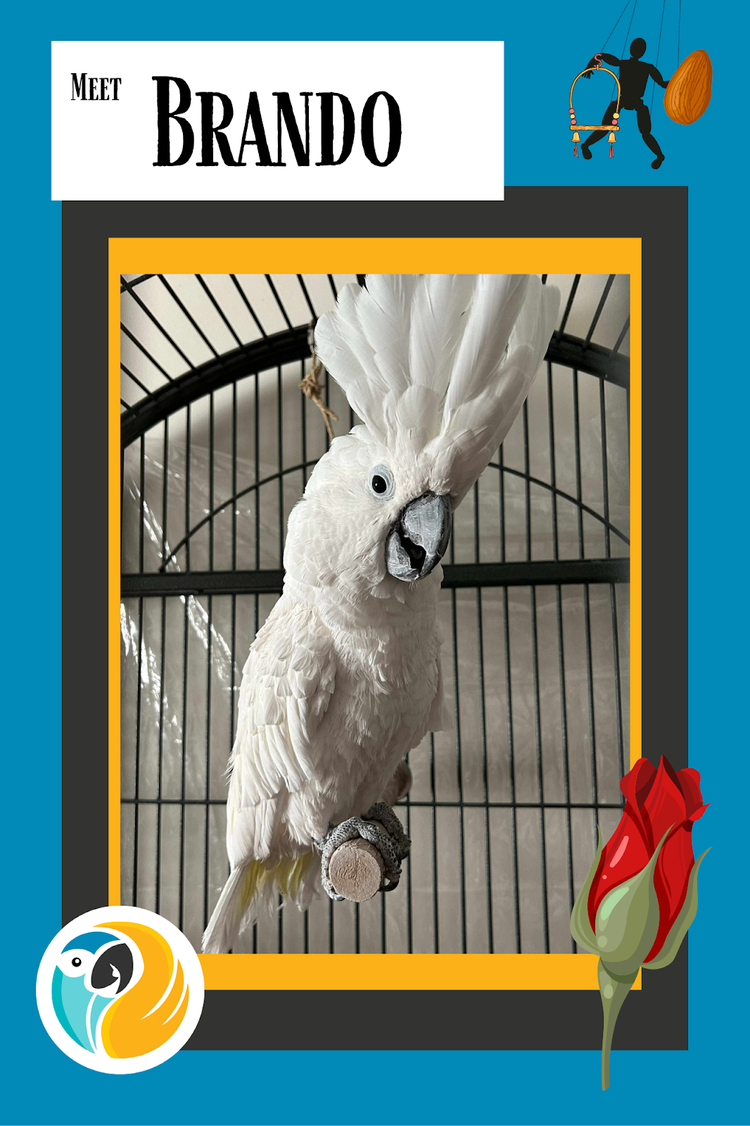
Meet Brando…
Brando is a typical male umbrella cockatoo who only wants to snuggle, get head scritches and be the center of your universe. He also loves to go on walkabout around his foster’s house to see what he could possibly get into to cause havoc. He must explore every inch of a house to ensure that his humans are safe (or that’s his story and he’s sticking to it). Brando doesn’t mind dogs, but he absolutely LOATHES cats. We aren’t sure what the cats in his foster home whispered to him through the bars, but he’s made it his mission to exterminate them. It’s suspected that cats might have formed their own mafia and it’s a turf war. Brando hasn’t yet convinced the dogs to join his empire…but it’s only a matter of time. Brando would prefer a home without cats so he can dimmish his role as the Godfather of his mafia and just enjoy life to its fullest.
Brando doesn’t seem to have any interest in the other main bird of the house (another cockatoo) but they aren’t allowed to interact with each other.
Brando would love to just lay on his chosen humans’ chest while they watch tv so they can give him all the head scritches he thinks he is entitled to, and in return, he will give you one of his amazing full wing hugs. Brando hasn’t yet decided if he likes bathing or not: he currently gets a mist bath from his foster, but he isn’t very impressed with it at all. Brando loves to let his foster caregiver work on the pin feathers on his head and will just melt into her.
Brando has recently become enamored of his foster’s 15-year-old niece and will come over to the side of the cage when she calls him, so she can give him head scritches. However, he does not seem to enjoy young children: he gets nervous, puts his crest up and will hiss at them. A home without children under the age of 10 will be required.
Brando does say “hello” in the saddest voice you have ever heard. His foster has not heard any other words from him other than his hello. He also has the saddest moans when he thinks he’s being neglected in his cage for too long. His noises would make a perfect background for a horror movie or dinosaur from Jurassic Park. He also does the typical cockatoo flock call in the evenings to make sure everyone is still in the house where they should be…..under his watchful eye. Brando doesn’t seem to scream as much or make a much noise as the other cockatoo in the house; however, due to the decibel levels of his calls, he will require a home without shared walls (i.e. apartments, duplexes, etc).
Brando currently is on a Zupreem Fruit Blend diet and doesn’t seem too interested in chop or fresh veggies. He will sometimes nibble a little if you make him a kabob out of the treats (his foster’s code for veggies). He gently takes bites of bananas from the 13-year-old teenager of the house.
It is important to note that Brando did not come with a suitable cage, so if approved for adoption, his new family will need to provide one of an appropriate size. Please do not purchase a cage before final approval is given for the adoption; we will advise what dimensions he will need as well as some places where they can be purchased.
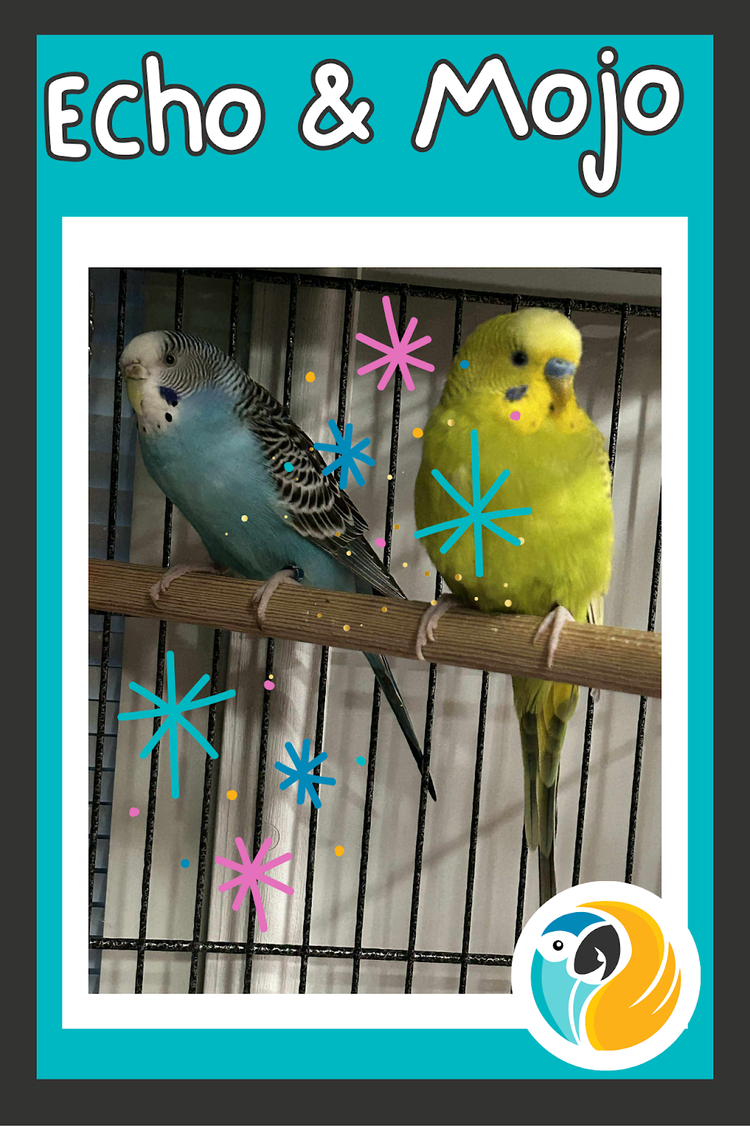
(some!) of the Top Ten Things About Echo and Mojo!
1- Mojo is male, blue and friendly: he will step up when asked!
2- Echo is the green and yellow female, and not as tame.
3- A budgie named Puck won the Guinness World Record for the largest vocabulary in 1995: he could say 1,728 words and created original sentences and phrases (though we have not heard from Mojo or Echo, they have the ability to speak if they want to!).
4- Budgies are very social, and even if they live with a partner or in a flock, they appreciate the company of people as well.
5- Mojo and Echo are thought to be around 6 years old; with proper diet and care, budgies in captivity have a lifespan from 10-20 years. The oldest budgie on record lived for more than 29 years!
6- Seed diets were the traditional food for budgies for many years (and what Mojo and Echo are used to eating), but to maintain good health, seed should only make up about 20% of their diet. The remaining 80% should come from a quality pellet and fresh vegetables and cooked legumes. While diet conversion for older birds can be difficult and slow, it is important for optimum health.
7- We call Mojo and Echo budgies, but in the U.S. they are better known as parakeets (technically speaking, they belong to the parakeet family, which include ringnecks, quakers, and alexandrines).
8- Budgies (and other parrots) process visual stimuli much faster than humans: 150 per second, compared to 16 – explaining their very fast reflexes!
9- While we do not advocate for keeping male/female pairs of birds together, Echo and Mojo are bonded – meaning that when/if separated, it causes immense depression, anxiety, and neurotic behaviors. Echo has laid eggs before, so it is important that if new eggs show up in her new home, they are disposed of quickly and appropriately – we have loads of budgies and don’t need more!
10-While Mojo and Echo can be chatty, and even noisy sometimes, their sounds are usually much more palatable than that of other parrots.
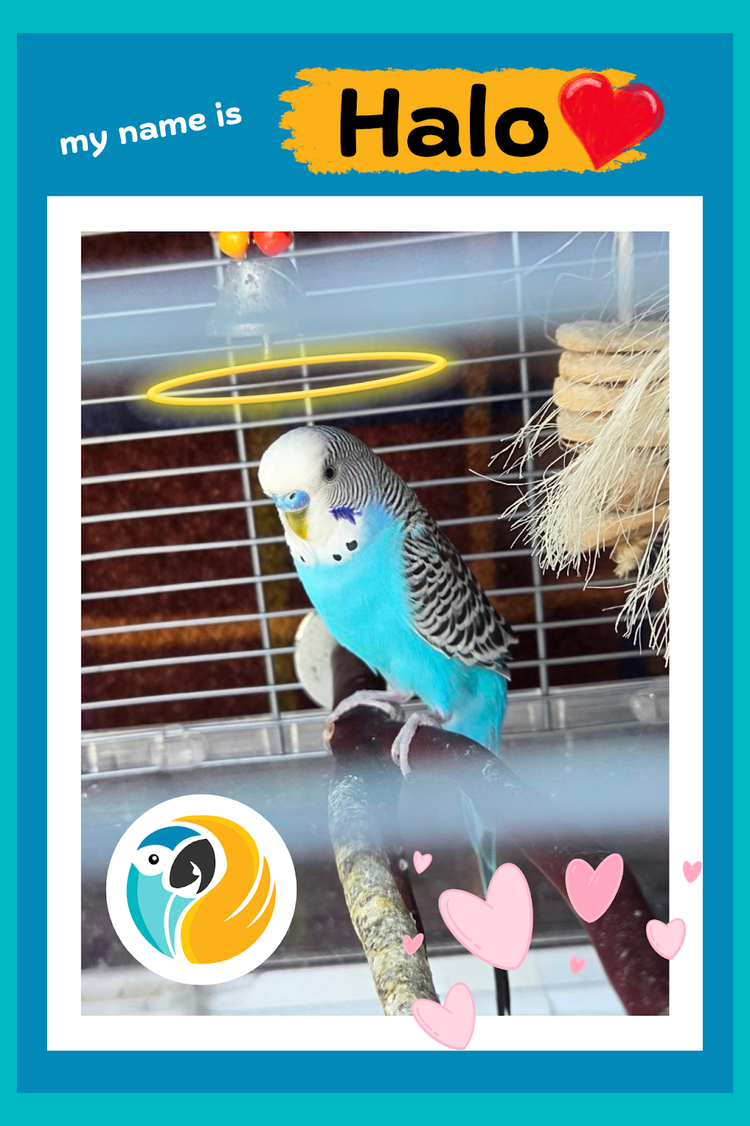
What is an Angel without her Halo? Halo is a budgie (assumed to be male, commonly known as a parakeet), about 3 ½ years old, and is being fostered in the same home as Angel, a blue and gold macaw that is also available for adoption! They are kept in very separate spaces from each other, Halo being so much smaller in size – but don’t tell him that!
Halo was surrendered when his previous owner had major life changes, and time to work and play with Halo was severely diminished. Prior to surrender, Halo was fairly tame and calm (for a budgie, also known as a parakeet), and would step up consistently for his owner. In his foster home, he is not as confident yet, but does not appear to be extremely fearful of hands in his cage. His previous owner noted that sometimes, Halo can be more fearful when he is away from the comfort of his cage, but this can be overcome. With a little patience, time, and love, Halo will be an easy little parrot to bond with!
In his previous home, Halo was an “only bird”, but he seems just as comfortable in the same room as the foster’s own budgie. While it can be difficult (and even dangerous) to house two unbonded adult parrots in the same cage, they can benefit from supervised out of cage time, and will display flock behaviors from separate cages (such as bathing, eating, and grooming at the same time). Parrots are very social creatures; if Halo will be an only bird in his new home, several hours a day should be dedicated to bonding and socializing between his new people and Halo.
Even small birds need toys and enrichment activities, and each individual will have different preferences. Halo’s foster has found that he enjoys toys made of small, softer wood and materials that he can chew and destroy (sola seems to be a favorite!).
If you would like to meet this sweet budgie, fill out an application today!